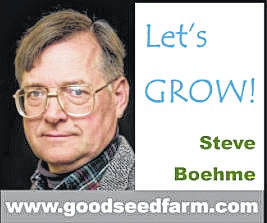
Job one in gardening and landscaping is loosening and enriching clay and compacted soil by mixing in organic materials like compost. For experienced gardeners, good compost is worth its weight in gold. There’s nothing healthier for your plants than rich black compost, but any kind of organic material mixed with soil is beneficial. Most gardeners buy compost in bags or bulk. Bagged compost and soils are in high demand, evidence that many gardeners aren’t making their own.
Compost is simply well-rotted organic material. Dead plants, leaves, wood, grass clippings, even kitchen waste can become compost if it’s simply mixed with air and allowed to rot. These materials are available in abundance all around you. A shocking amount of compost ingredients are burned, discarded, or buried in landfills. You can easily convert them into rich garden soil by adding oxygen. The only other thing you really need to make terrific compost is time.
You already know how good compost is for your garden, but how can you have an unlimited free supply of it without a lot of hard work? We’ve seen all kinds of expensive gadgets for making compost, from rolling “drums” to plastic boxes, to tubs you bury underground. Even if they actually work, these toys will never generate enough compost for serious landscaping. The thing they do best is separate you from your hard-earned money.
It’s possible to complicate the subject of compost so much that you’d need a biology degree to make sense of it. Whole books have been written about it, and fancy research on the topic is readily available. I don’t pretend to be a compost expert; much of what I know about compost I learned by watching my grandmother.
My grandmother didn’t have any more time than you do, so she made compost with the least effort possible. Next to her vegetable garden she made a three-sided box with old cinder blocks (railroad ties work great, too). Anytime she had any kind of clippings, autumn leaves, cuttings, peelings, garbage, dead plants, used potting soil or other yard waste she just added it to the pile inside the box. Sometimes the box would be completely full, but over time it would settle and she would add more.
Every spring she spread the compost on her garden and tilled it in. She mulched her vegetables with compost, to keep down the weeds. Any time she planted anything in the yard she’d raid the pile, mixing the compost in as she planted. Not scientific, but I can testify that she had the most gorgeous black fluffy garden soil I’ve ever seen, and she grew terrific vegetables.
When Marjorie and I bought our first house and we wanted to landscape, there was no compost, only gooey clay soil. I built a compost bin like my grandmother’s but with some low-tech enhancements. I set it into a bank so I could dump my wheelbarrow into it from the uphill side, and I built a second box right next to it. I forked the pile from one box to the other a few times, turning it over, to speed up the process. Mixing compost with air really speeds up composting. My favorite ingredient was autumn leaves mixed with grass clippings. I bagged the leaves and clippings together when I mowed the lawn; the nitrogen-rich clippings helped break down the chopped-up leaves quickly.
After a few years we had all the compost we needed, so I stopped turning the piles. I just switched each year from one box to the other, so I wasn’t adding fresh stuff on top of the old pile. Once the older compost was used up, I would switch sides.
Compost experts will find many faults with my method. The most important is that, without carefully managing the temperature of the pile, we didn’t sterilize all the compost evenly. It would be possible for weed seeds, insect eggs and possibly plant diseases to survive and get spread around. In theory, bagged compost you buy is sterile, and if that’s what you want my method isn’t for you. I think the perfect can be the enemy of the merely good; plentiful free compost beats skimpy expensive compost you have to haul home in bags.
The important thing is to start right away, and to NEVER AGAIN THROW AWAY (or worse yet, burn) any kind of yard waste. With luck, your neatnik friends will bring all their yard waste to you and help you build your pile. You can pay them back with one-pound tomatoes from your garden…
Steve Boehme is a landscape designer/installer specializing in landscape “makeovers”. “Let’s Grow” is published weekly; column archives are online at www.goodseedfarm.com. For more information call GoodSeed Farm Landscapes at (937) 587-7021.


